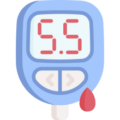Author(s)
John Andraos, PharmD
Alexa Zeiger, PharmD
Michael S. Kelly, PharmD, BCACP, CDE, CLS
Reviewed By
Emily Eddy, Pharm.D., BCACP
Brittany Long, Pharm.D., BCACP
Gregory Castelli, PharmD, BCPS, BC-ADM
McMurray JJV, Solomon SD, Inzucchi SE, et al. Dapagliflozin in Patients with Heart Failure and Reduced Ejection Fraction. N Engl J Med. 2019; 381: 1995-2008.
The Problem
Heart failure with reduced ejection fraction (HFrEF) is associated with significant morbidity and mortality. Current guidelines (Check out the iForumRx Heart Failure – Key Clinical Trials and Guideline Page) recommend a renin-angiotensin inhibitor, beta-blocker, and aldosterone antagonist to reduce morbidity and mortality in these patients.1 Despite the use of multiple drug classes, 5-year mortality rates hover near 50% in patients with heart failure (HF).2 Although the number of deaths from heart disease have declined in recent years, deaths from HF have actually increased by 38%.3
Newer agents, such as sacubitril-valsartan and ivabradine, lower the risk of hospitalization for worsening HF in symptomatic patients with HFrEF. In the PARADIGM-HF trial, sacubitril-valsartan reduced mortality.4 Despite the numerous medications available, mortality and the risk of HF hospitalizations remains high. Sodium-glucose cotransporter-2 inhibitors (SGLT2-I) have been shown to reduce HF hospitalizations in patients with diabetes. Could this medication class be useful for HF treatment even in patients without diabetes?
What’s Known
Data for the SGLT2-I class in reducing HF hospitalizations is well characterized in patients with diabetes based on the data from three landmark cardiovascular outcomes trials. The EMPA-REG trial (empagliflozin) reported a reduced risk of the composite cardiovascular outcome among patients with type 2 diabetes (T2DM) at increased cardiovascular risk , as well as reduced the risk for all cardiovascular mortality and hospitalization for HF.5 The CANVAS trial (canagliflozin) reported a similar reduction in the primary composite cardiovascular outcome and hospitalization for HF among patients with T2DM and increased cardiovascular risk.6 While the DECLARE-TIMI 58 trial (dapagliflozin) did not achieve a statistically significant reduction in the primary composite cardiovascular outcome, it too demonstrated a reduction in HF hospitalization similar to the previous SGLT2-I trials.7 These data led the American Diabetes Association (ADA) in 2019 to recommend a SGLT2-I as the preferred add-on agent in patients with diabetes with comorbid ASCVD or HF.8 The exact mechanism by which SGLT2-I impart these cardiovascular benefits is unknown, but might be related to diuretic/hemodynamic effects, effects on myocardial metabolism, ion transporters, fibrosis, adipokines, and improved vascular function.9 Whether patients with HFrEF without T2DM would experience similar benefits was uncertain…until now.
What’s New
DAPA-HF was an international, phase 3, placebo-controlled trial sponsored by the pharmaceutical manufacturer. The study evaluated the addition of dapagliflozin 10 mg to the standard of care for patients with HFrEF.10 Eligible patients included adults with an ejection fraction ≤40% and NYHA class II-IV symptoms while receiving beta-blocker plus renin-angiotensin inhibitor therapy (including ACE-I, ARB, or sacubitril-valsartan). Patients were also required to have a N-terminal pro-B-type natriuretic peptide (NT-proBNP) ≥600 pg/mL or ≥400 pg/mL in those hospitalized for HF within the previous year. Key exclusion criteria included type 1 diabetes, low systolic BP (<95 mmHg), and eGFR <30 ml/min/1.73 m2. Patients were stratified by presence of T2DM at baseline. The primary endpoint was a composite of worsening HF (either hospitalization or urgent visit resulting in intravenous therapy for HF) or cardiovascular death. Secondary endpoints also included total number of HF hospitalizations, changes in Kansas City Cardiomyopathy Questionnaire (KCCQ) score, worsening renal function, and death from any cause.
A total of 4,744 patients were enrolled and followed for a median of 18.2 months. Baseline characteristics were similar among study groups (Table 1). The vast majority of patients received guideline-directed medical therapy based on the recommendations from the American College of Cardiology/American Heart Association HFrEF treatment guidelines.
Table 1: Baseline Characteristics of the DAFA-HF Study Population
|
Characteristic |
Dapagliflozin (n=2373) |
Placebo (n=2371) |
|
Age (years) |
66.2 ± 11.0 |
66.5 ± 11.0 |
|
Male (%) |
76.2 |
77 |
|
Race (%) White Black Asian Other |
70.0 5.1 23.3 1.6 |
70.5 4.4 23.8 1.3 |
|
Region (%) North America South America Europe Asia-Pacific |
14.1 16.9 46.1 22.9 |
14.4 17.5 44.7 23.3 |
|
NYHA classification (%) II III IV |
67.7 31.5 0.8 |
67.4 31.7 1.0 |
|
HF medication (%) Beta-blocker ACE-I or ARB Sacubitril-valsartan Aldosterone antagonist Diuretic Digoxin |
96.0 84.5 10.5 71.5 93.4 18.8 |
96.2 82.8 10.9 70.6 93.5 18.6 |
Rates of the primary composite outcome were significantly lower in patients who received dapagliflozin compared to placebo, resulting in a NNT of 21 patients over 18 months (See Table 2). Each of the individual components of the primary outcome occurred significantly less frequently in the dapagliflozin group compared to placebo. Patients in the dapagliflozin group also had significantly greater symptom improvement based on changes in the KCCQ score. Pre-specified safety outcomes included evidence of volume depletion, fracture, amputation, and diabetic ketoacidosis. All of these events were rare and occurred at similar rates in both groups. Overall, discontinuation due to adverse events occurred in 4.7% and 4.9% of patients receiving dapagliflozin and placebo, respectively.
Table 2: Primary and Select Secondary Outcomes in DAPA-HF Study
|
Outcome |
Dapagliflozin |
Placebo |
Hazard Ratio and 95% CI |
|
Primary composite outcome |
16.3% |
21.2% |
0.74 (0.65-0.85) |
|
Hospitalization or urgent visit for HF |
10.0% |
13.7% |
0.70 (0.59-0.83) |
|
Hospitalization for HF |
9.7% |
13.4% |
0.70 (0.59-0.83) |
|
Cardiovascular death |
9.6% |
11.5% |
0.82 (0.69-0.98) |
|
All-cause mortality |
11.6% |
13.9% |
0.83 (0.71-0.97) |
|
Change in KCCQ symptom score at 8 months |
6.1±18.6 |
3.3±19.2 |
1.18 (1.11-1.26) |
The benefits of dapagliflozin was seen across nearly all prespecified subgroups, including those with and without T2DM. Those with NYHA class III or IV appeared to benefit less than patients with NYHA class II symptoms. Additional post-hoc subgroup analysis found that patients taking sacubitril-valsartan at baseline had a similar benefit in the primary outcome (HR: 0.75; 95% CI, 0.50-1.13) as those taking an ACE-I or ARB (HR: 0.74; 95% CI, 0.65-0.86). But because this subpopulation was rather small, the 95% confidence interval crossed the line of equivalence.
Our Critical Appraisal
The DAPA-HF study was well-designed study that was adequately powered to assess the superiority of adding dapagliflozin to guideline-recommended medical therapy in patients with HFrEF. The study groups were well matched and a very high percentage of participants were receiving recommended medications to reduce morbidity and mortality associated with HFrEF. The primary composite endpoint of HF hospitalization or cardiovascular death is appropriate and similar to the endpoints used in contemporary HF trials. These endpoints are relevant to patients and clinicians. The improvement in KCCQ scores indicates patients felt better as well.
Limitations of this study include lack of diversity in its population. A majority (approximately 70%) of the patients were white, there were few very elderly patients, and males were over-represented (3:1 ratio relative to female participants). Furthermore, only 14% of patients were from North America, which may limit the application of these findings to the patients seen in the U.S. healthcare system. Lastly, the inclusion criteria limited study enrollment to patients with elevated NT-proBNP, which may suggest that these patients were volume overloaded and might benefit from additional diuresis.
While study patients received recommended medical therapy, no information was reported about the dosing of these agents. Thus, some, perhaps many, patients may have been on lower than recommended doses. Subgroup analysis suggested that those with more symptomatic HFrEF, NYHA classifications III and IV, were less likely to benefit from dapagliflozin compared to those with less debilitating symptoms. However, subgroup analysis of patients with a baseline ejection fraction below the median of 31% did not differ from those with an ejection fraction above the median. Additionally, the benefit of dapagliflozin was consistent across subgroups with baseline NT-proBNP levels above the median and by history of HF hospitalization. Whether dapagliflozin benefits patients treated with sacubitril-valsartan is less certain as the majority of patients were treated with a recommended ACE-I or ARB.
The Bottom Line
The DAPA-HF trial provides strong evidence that in patients with HFrEF dapagliflozin reduces the risk of worsening HF and prevents cardiovascular death even in patients without diabetes. This benefit is likely a class effect of the SGLT2-I medications, but this conjecture will need to be confirmed in currently ongoing clinical trials. Recently, dapagliflozin received an official FDA indication to reduce the risk of HF hospitalization in adults with T2DM and ASCVD or multiple cardiovascular risk factors. It seems likely that the ideal HFrEF treatment cocktail in the future will include a renin-angiotensin inhibitor, beta-blocker, aldosterone antagonist, and SGLT2-I.
The Key Points
- Dapagliflozin when used as an add-on treatment in patients with NYHA Class II-IV HFrEF significantly reduces the risk of HF hospitalizations and cardiovascular death.
- The benefits of dapagliflozin were consistent regardless of whether a patient has diabetes or not.
- Additional studies assessing SGLT2-I in patients with HFrEF are ongoing and will determine whether the heart failure benefits are a class effect.
FINAL NOTE: This program will be available for recertification credit through the American Pharmacists Association (APhA) Ambulatory Care Review and Recertification Program. To learn more, visit https://www.pharmacist.com/ambulatory-care-review-and-recertification-activities.
1. Yancy CW, Jessup M, Bozkurt B, et al. 2017 ACC/AHA/HFSA Focused Update of the 2013 ACCF/AHA Guideline for the Management of Heart Failure: A Report of the American College of Cardiology/American Heart Association Task Force on Clinical Practice Guidelines and the Heart Failure Society of America. J Am Coll Cardiol. 2017;70(6):776-803. doi:10.1016/j.jacc.2017.04.025
2. Benjamin EJ, Muntner P, Alonso A, et al. Heart Disease and Stroke Statistics—2019 Update: A Report From the American Heart Association. Circulation. 2019;139(10). doi:10.1161/CIR.0000000000000659
3. Sidney S, Go AS, Jaffe MG, Solomon MD, Ambrosy AP, Rana JS. Association Between Aging of the US Population and Heart Disease Mortality From 2011 to 2017. JAMA Cardiol. October 2019. doi:10.1001/jamacardio.2019.4187
4. McMurray JJV, Packer M, Desai AS, et al. Angiotensin-neprilysin inhibition versus enalapril in heart failure. N Engl J Med. 2014;371(11):993-1004. doi:10.1056/NEJMoa1409077
5. Zinman B, Wanner C, Lachin JM, et al. Empagliflozin, Cardiovascular Outcomes, and Mortality in Type 2 Diabetes. N Engl J Med. 2015;373(22):2117-2128. doi:10.1056/NEJMoa1504720
6. Neal B, Perkovic V, Mahaffey KW, et al. CANVAS Programme Collaborative Group. Canagliflozin and Cardiovascular and Renal Events in Type 2 Diabetes. N Engl J Med. 2017;130(2):149-153. doi:10.1056/NEJMoa1611925
7. Wiviott SD, Raz I, Bonaca MP, et al. Dapagliflozin and cardiovascular outcomes in type 2 diabetes. N Engl J Med. 2019;380(4):347-357. doi:10.1056/NEJMoa1812389
8. Association AD. Pharmacologic Approaches to Glycemic Treatment: Standards of Medical Care in Diabetes-2019. Diabetes Care. 2019;42(Suppl 1):S90-S102.
9. Li J, Woodward M, Perkovic V, et al. Mediators of the Effects of Canagliflozin on Heart Failure in Patients With Type 2 Diabetes. JACC Hear Fail. October 2019. doi:10.1016/j.jchf.2019.08.004
10. McMurray JJV, Solomon SD, Inzucchi SE, et al. Dapagliflozin in Patients with Heart Failure and Reduced Ejection Fraction. N Engl J Med. September 2019:NEJMoa1911303. doi:10.1056/NEJMoa1911303





 iForumRx.org is a web-based community of practice designed to inform ambulatory care pharmacy specialists, pharmacy residents, and student pharmacists about high-quality, practice-changing evidence.
iForumRx.org is a web-based community of practice designed to inform ambulatory care pharmacy specialists, pharmacy residents, and student pharmacists about high-quality, practice-changing evidence.